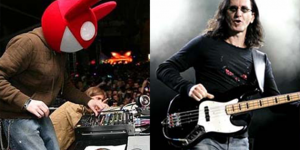TRENDSPOTTING: The rise of electronic music and a new class of arena-rock royalty
by Richard Trapunski
August 16, 2012
Photo by Ethan Saks courtesy of Atlantic Records
It’s been called everything from “The New Rave Generation” to “The Summer of Wub” to the “The New Rock,” but it’s impossible to ignore: electronic dance music is big business. In a year where Swedish House Mafia sells out Madison Square Garden, Deadmau5 rocks the Rogers Centre, Skrillex dominates the Grammys and Tiesto earns $22 million dollars, you can’t escape the truth that EDM has finally outgrown (or sidestepped) its underground roots once and for all and entered the mainstream.
“If you’re 15 to 25 years old now, this is your rock ‘n’ roll,” Michael Rapino, chief executive of North America’s biggest promotion company, Live Nation Entertainment, told the New York Times back in April, a quote that was picked up and disseminated across various major publications. He’s not necessarily saying anything new; in fact this seems a lot like history repeating itself. “Electronica,” as it was then called, was pushed and marketed as “the new rock” back in the ‘90s, hitched to major touring acts like The Prodigy, Moby, the Chemical Brothers, and the Crystal Method. However, the claim actually makes a lot more sense now than it did then.
In an interview for 24 Hours newspaper in Toronto this week, I asked managing director of Live Nation Canada’s new Electro Music Division, Ryan Kruger, how, just years after the electronic music scene was dismal enough for him to cancel his lifelong event, the World Electronic Music Festival (WEMF), it’s now strong enough to bring it back bigger than ever. Kruger, who has been active on the scene since the early ‘90s as both a promoter and a DJ, argued something similar to Rapino: the current crop of EDM fans weren’t around to see the early days of Rave, Trance and Techno. Those “15 to 25 year olds” mentioned by Rapino only really know the scene created by the more aggressive, testosterone-laden strains of dubstep and drum and bass practiced by new sensations like Skrillex, Zed’s Dead, Aviciii, and whatever other wunderkinds are headlining all the new festivals rapidly sprouting up such as HARD, VELD, Digital Dreams, Full Flex Express, and climbing higher on the bills of established mega-fests like Coachella and Lollapalooza.
They’re not old enough to remember the days when dance music was still considered underground, the days of flier promotion, secret locations, and ecstasy-fuelled warehouse raves. Today’s EDM culture takes place at arenas and giant outdoor festival stages. Sure, by the time MTV picked up, and subsequently banned, something like “Smack My Bitch Up,” an act like the Prodigy could no longer lay any claim to underground status, but that doesn’t change the fact that it grew out of, and was marketed upon, its furtive, cool, anti-dinosaur mentality. Nowadays, kids don’t bat an eyelash when their event carries corporate branding or is booked by Live Nation; they’re just waiting for the drop.
Acts like Skrillex, then, aren’t opposing major touring rock acts like U2 and Coldplay, but actually filling the void left by the lack of bona fide new stadium-fillers. And they actually have a lot in common. Where even the mega DJs were once relegated to a booth in the corner of the room, today’s biggest acts take their perch front and centre, leading the crowd with stadium-rock tactics. Deadmau5’s lights and pyrotechnics, Skrillex’s crowdsurfing, Justice’s endless mugging—they’re all timeless rockstar moves. That shouldn’t come as too much of a shock. Rather than underground dance backgrounds, many of them actually come from rock backgrounds. Skrillex, for instance, first made his mark as part of a metalcore band and, as Stereogum convincingly argues, his popularization, privileging, and ritualization of the drop—the moment where the bass drops out and the whole room loses its shit—has its precedent in the crowd-controlling aggression of his previous gig. It’s no wonder guys like Jonathan Davis of Korn (now J Devil) are able to make the leap from nu metal to dubstep without any major changes. Or for Madonna, Nicki Minaj, and the Black Eyed Peas to profit from it in the pop sphere (often via David Guetta).
Ironically, though, the spread of EDM has actually taken place on a very grassroots level. Where ‘90s electronica had major marketing machines behind it, Skrillex found his fame online first. Without any major radio backing, the music was created on computers and disseminated that way. But that’s how those 15 to 25 year olds get their music. They’re the first generation to be socialized on the internet. Once the sponsors and promoters and the industry realized there was money in those wubs, they hopped on board. Once the Springsteens and McCartneys retire, it’s conceivable to see Skrillex and Deadma5 become the dinosaurs.
EDM is the new rock? Not so far fetched after all.
Tags: Music, Featured, News, david guetta, Deadmau5, EDM, skrillex, Trendspotting





